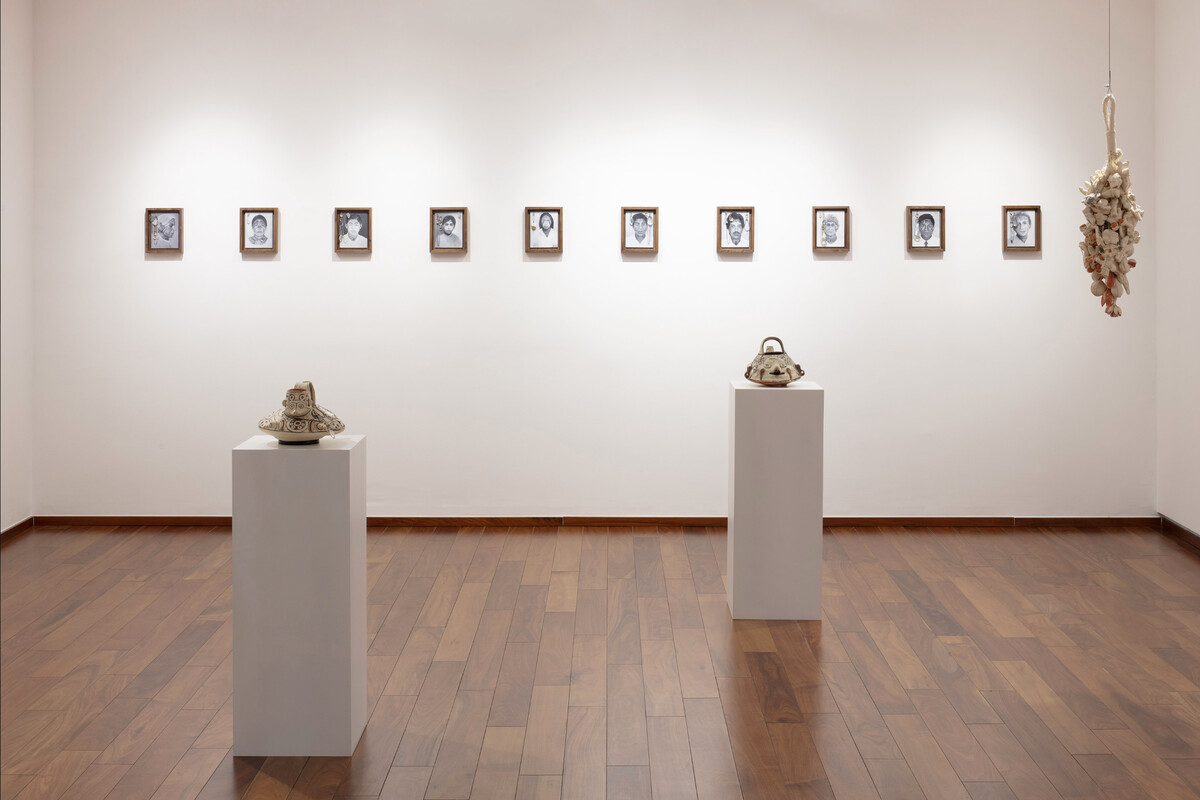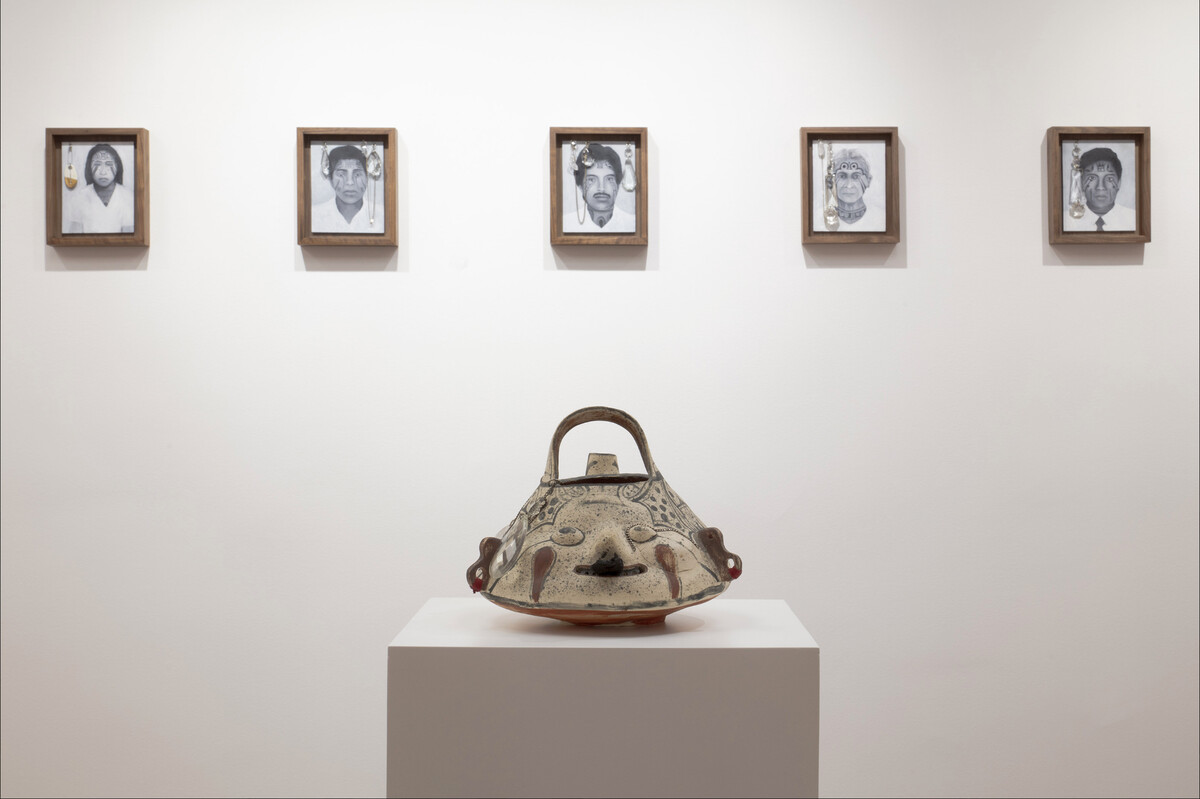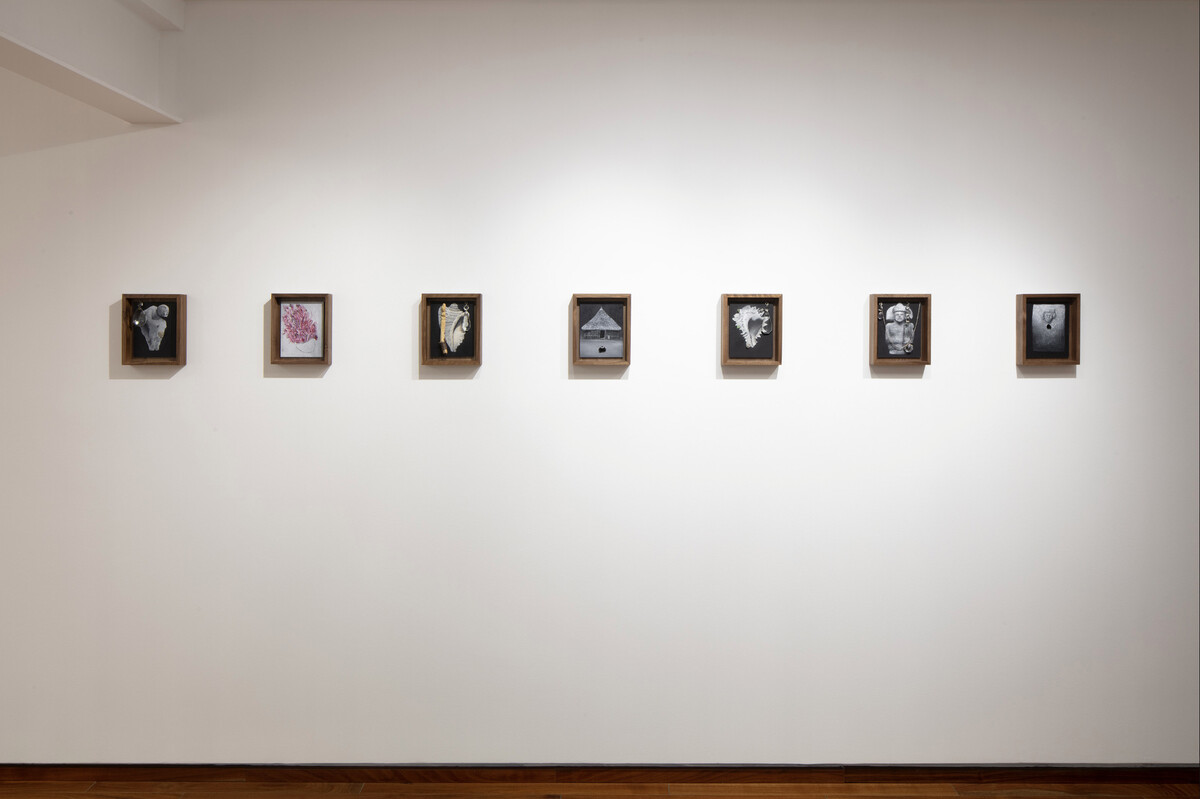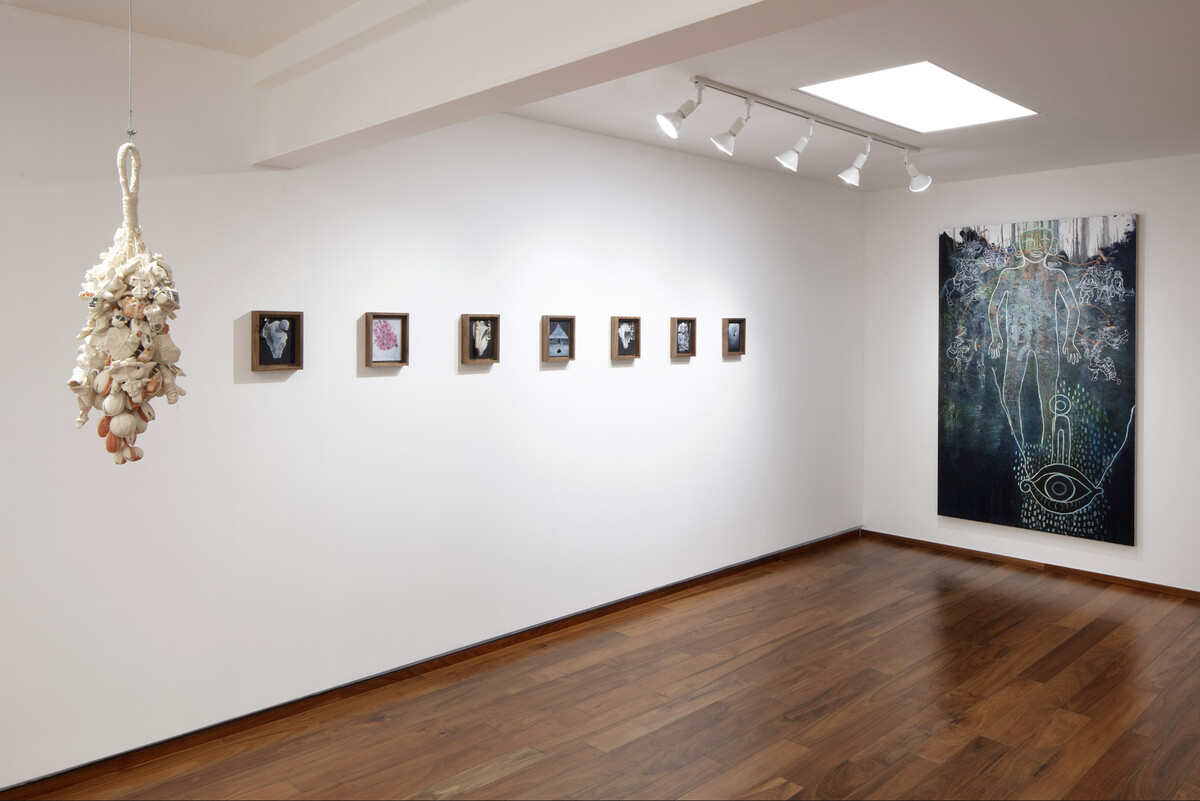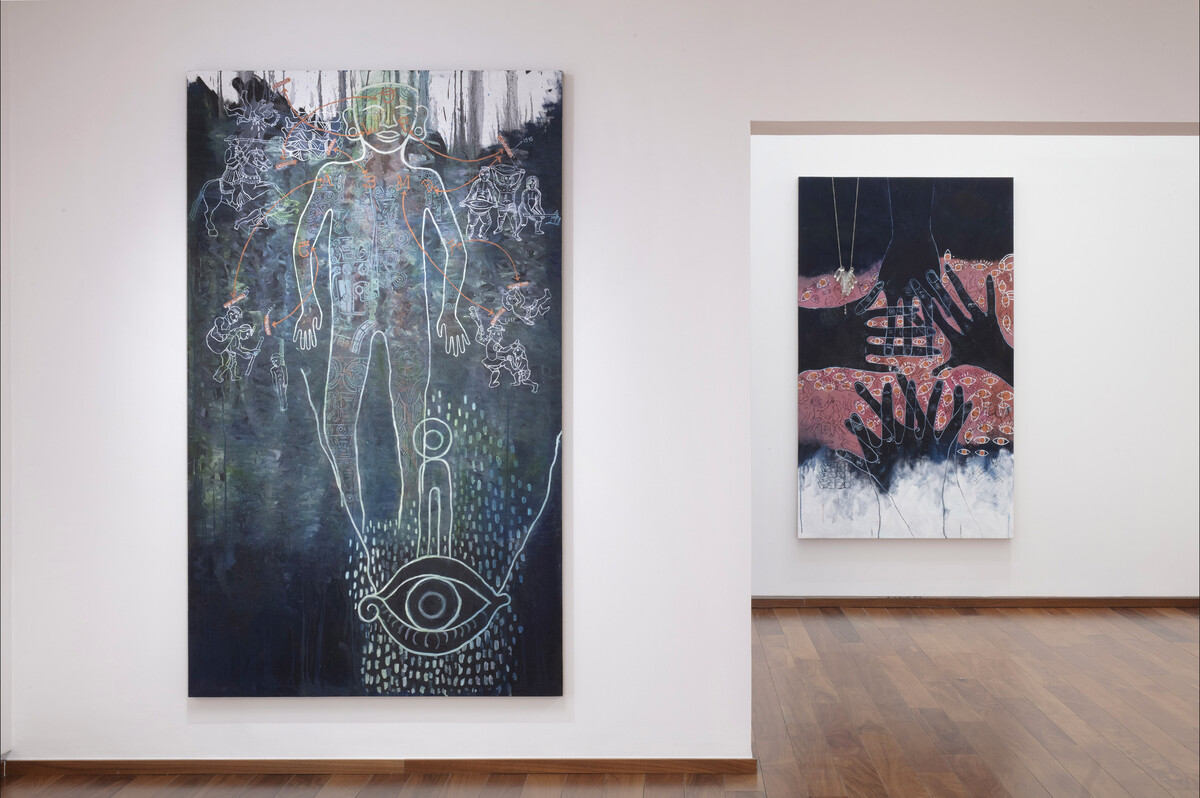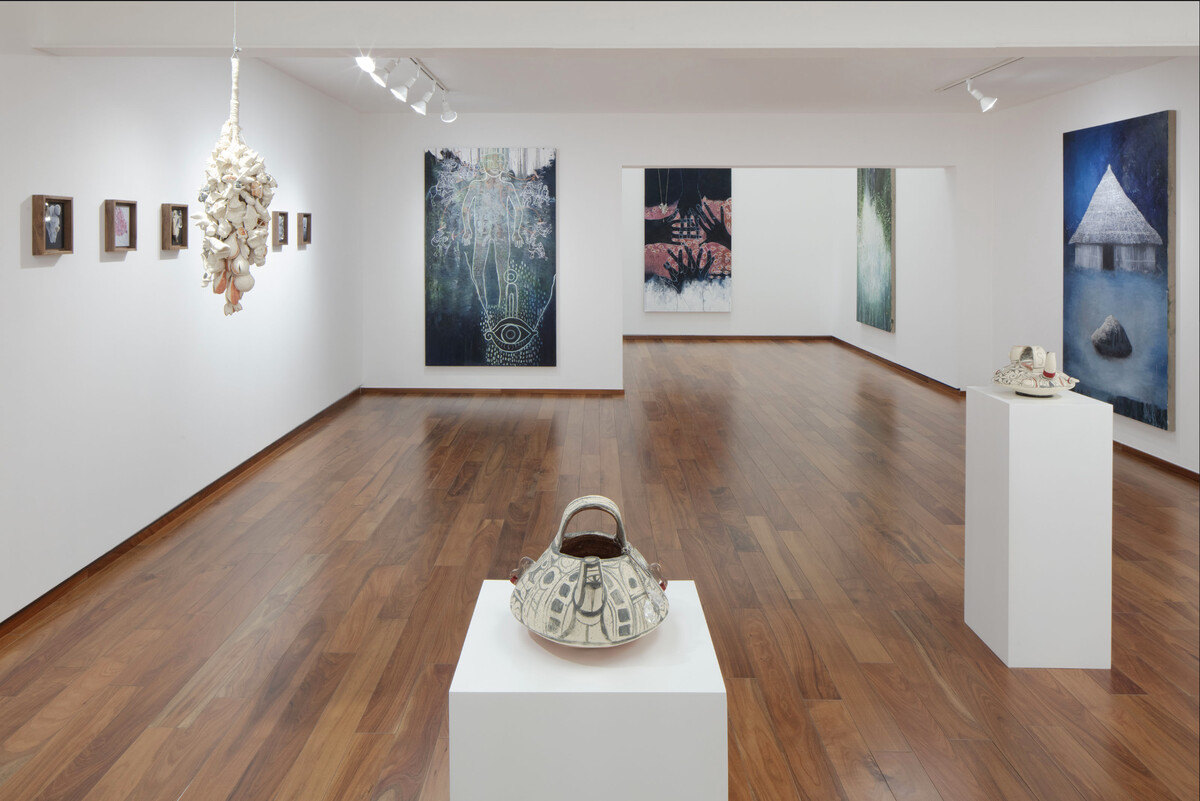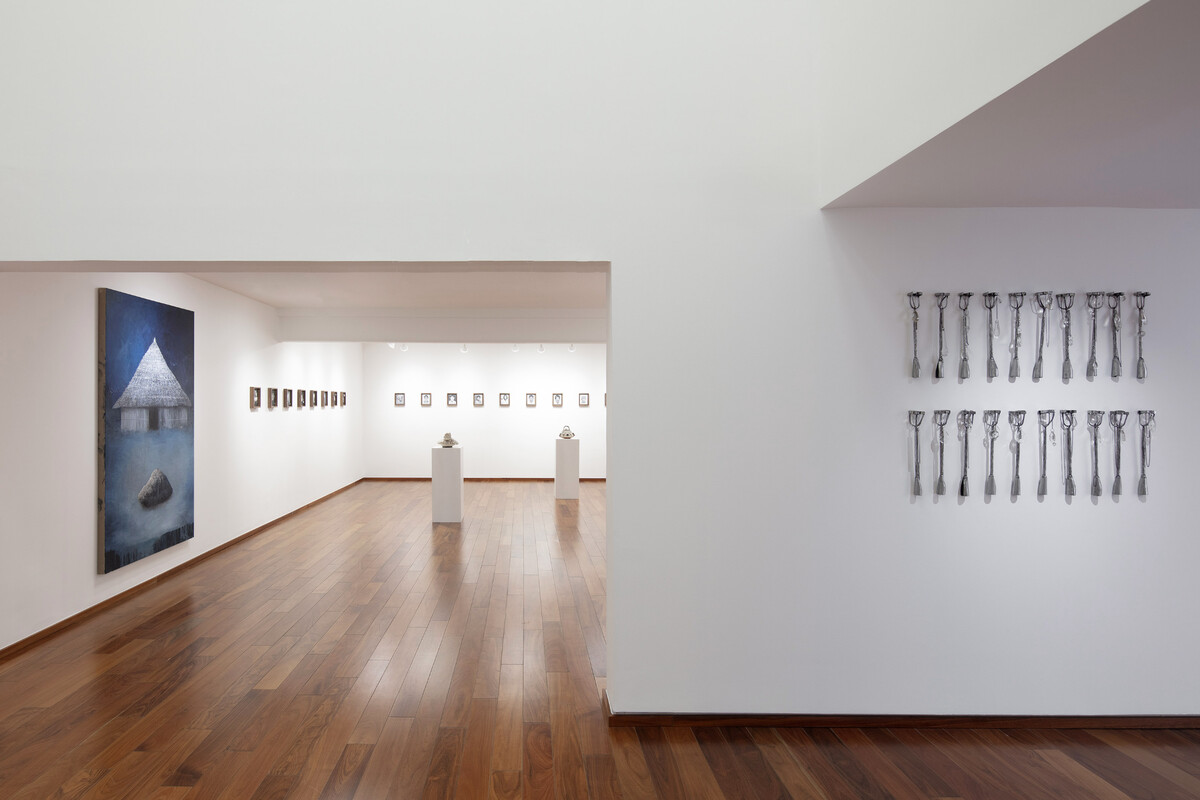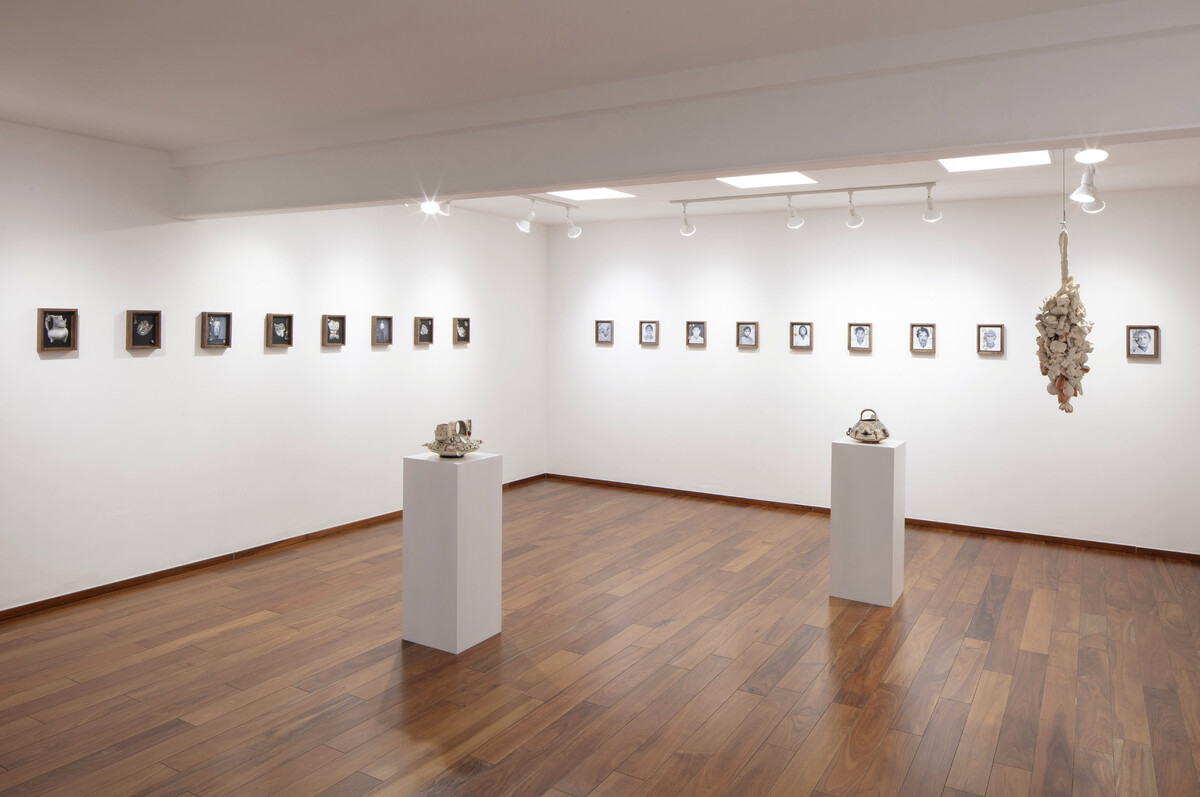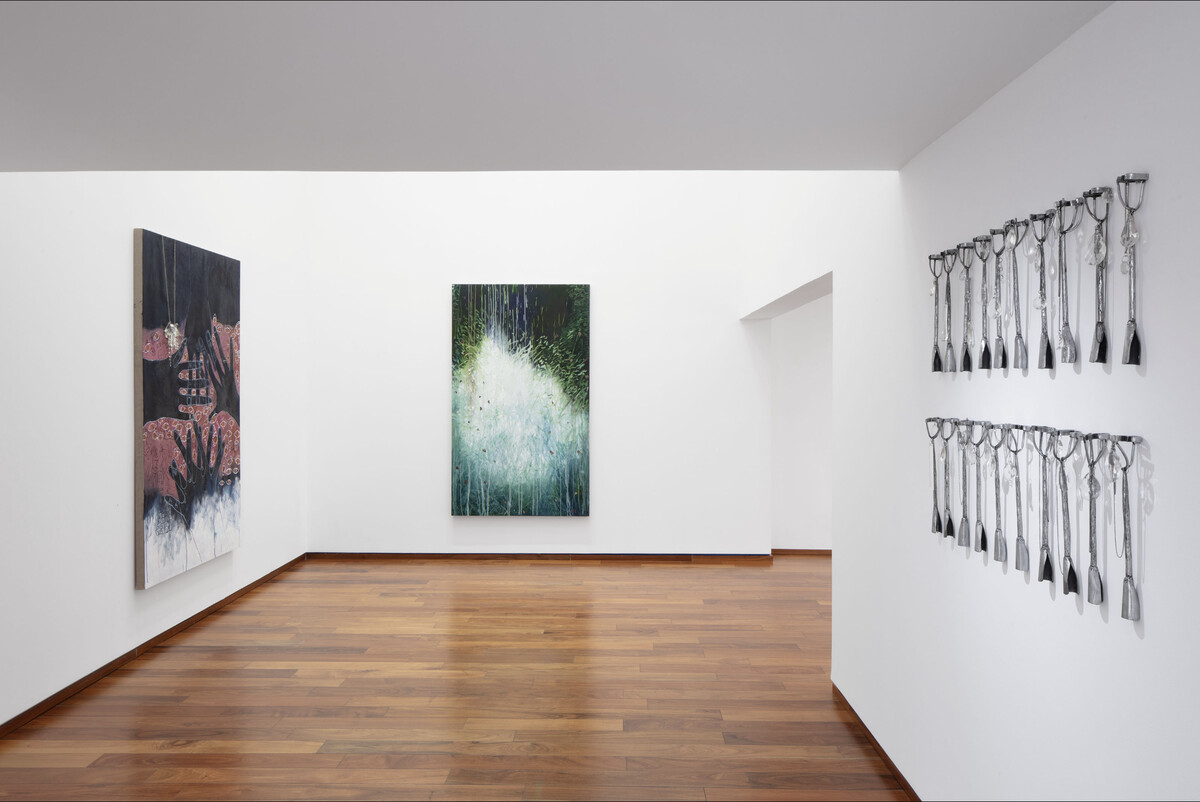
Embodied Modes of Resistance: Dream Technologies, Silenced Histories, and Family Memory
Noé Martínez’s work is deeply rooted in the history of slavery in the Huastec region, where his family comes from. This thematic exploration connects directly to his earlier work, continuing his engagement with personal and collective histories. The genesis of this inquiry lies in a set of dreams in which the artist visualized scenes that he later linked to the history of slavery in the region. These embodied visions marked a turning point in his practice, prompting a shift from curatorial work to deeply-rooted research and artistic creation.
This transformative process is part of what Noé defines as “western de-education,” a deliberate unlearning of the mental, physical, and emotional frameworks imposed by coloniality and their resulting neuroses. His artistic practice seeks to share this process of liberation through visual vocabularies and methodologies that do not just critique, but also rebuild. Crucially, Martínez’s focus operates not from an abstract or theoretical point of view, but rather from a personal perspective. While much of the discourse about coloniality and the politics of identity is maintained on the terrain of theory and denunciation, his work delves into the sphere of the intimate, highlighting the personal as something inherently political.
The works in this exhibition approach colonial history through the artist’s personal history and lineage. This decolonial critique is embodied in his family tree, which he reconstructs piece by piece, down to the smallest detail, despite the inevitable gaps in the historical record. For him, the precision of a literal reconstruction is less important than the symbolic and political meaning of such an undertaking. Martínez’s work prioritizes symbolic experience and its political resonance, anchoring his practice in the world of dreams as a technology for intergenerational knowledge transmission. For the artist, dreams are a bridge toward the worlds of those who are no longer physically present, but whose guidance continues shaping the living.
The exercise of filling in the empty spaces in historical and archival records is enriched by the artist’s practice of dreaming, while the ambiguities of the dreams are clarified through historical research. This dual focus arose as a need of an artist shaped by a generation marked by events like the mass kidnapping in Iguala. The violence and lack of accountability in the world around him led him to look inward, prompting him to seek knowledge, evidence, and proof, not only so as to demand accountability, but also to reformulate narratives and to develop non-colonial forms of healing. This search responds to the deep trauma (el susto, or “fright”) that Noé Martínez identifies as a colonial symptom, manifesting itself in both individual and collective psyches.
Central to the artist’s methodology is the use of dreams as a decolonial tool, a practice that resonates with Gloria Anzaldúa’s concept of nepantla, a liminal space of transformation where ancestral and personal knowledge intersect. The result of this conscious effort is a unique knowledge system that unites the personal and the historical, the micro and the macro. Martínez’s practice demonstrates the urgency of non-colonial methodologies in everyday life, not only within theoretical frameworks. For him, knowledge is never static or crystallized; it is a fluid, dynamic process, capable of encompassing complexity and continuously incorporating new pieces of historical truth. His work is less like a monolithic, immobile sculpture than a mosaic whose reconfigurable fragments reveal nuanced narratives in constant evolution.
One series of works in this exhibition consists of small-format paintings that evoke family photographs from the mid-twentieth century. This intimate format allows the artist to focus on the physiognomic details of his ancestors: their faces, gazes, and expressions, as they appeared in his photographs or dreams. The small format also bestows a meditative quality on the act of painting, putting him face to face with his ancestors. Each portrait becomes a small act of resistance, one piece in a larger puzzle that forms a network of affective connections and living traces of survival.
These portraits are made on copper, a material that is often used to produce sounds that are believed to dispel el susto. Copper’s reflective surface also serves as a means of conjuration and invocation. The faces that emerge from these surfaces are adorned with tattoos inspired by the body markings recorded on archaeological pieces from the Huastec region, a collective form of writing that existed for thousands of years. Noé transposes these motifs from tattoos to the faces of his relatives, creating a continuity between the pre-Hispanic past and the present.
Sometimes, however, historical records and dreams are not enough to provide a complete reconstruction. In such cases, Noé Martínez relies on himself, using his own facial features to fill in the empty spaces in his family tree. Where visual representation is completely absent, he refuses to let memory disappear. Instead, objects, material details, and even words become strategies for embodying modes of knowledge, lives, and modes of resistance. Crystals have a particular importance among these objects. Originally markers of bourgeois colonial status in the eighteenth and nineteenth centuries, these objects are now reused by Haustec curanderos as healing tools. In his work, these crystals articulate a more complex understanding of resistance, memory, and resilience, which incorporates colonial instruments of power, transformed into tools of repair and survival.
Retracing these family lines and extending them into the present becomes a way of fighting against erasure and oblivion, both inherent in the colonial process. The exercise of reconstructing his family tree is a deeply intimate form of political resistance. Saidiya Hartman’s notion of “critical fabulation,” which seeks to reimagine and give voice to silenced histories, is palpable in this process. To reiterate the relevance of those who preceded us becomes a way of honoring their survival in the face of necropolitical forces. Martínez brings the knowledge and memory of them into the present, treating time as a complex, elastic, and stratified entity. This intimate act of recollection is the profoundest form of resistance: a re-existence. Faces from the past become seeds that can sprout into new modes of knowledge and consciousness, a focus he describes as “capturing drops of fog to create water.” His work constructs a collective body, a family album that becomes an offering to those who came before him.
The exhibition also includes a series of large-format paintings, which expand this dialogue with the invisible. These works refer to the numerology of the four cardinal directions and are rooted in specific moments when the artist’s dream processes intersect with historical elements. One of these works, The Shadow of the Mountain Has Tattoos, reflects a central pillar of indigenous epistemology: the concept of the shadow. In Martínez’s birthplace, anything that has a shadow is considered to be alive. This work fuses the shadow motif with the imaginary of tattoos, representing a continuity of thought and knowledge between the past and the present. The mountain and its shadow are witnesses to the histories of the communities they observe, embodying memory as much as the tattoos engraved on the figures of his pieces.
The strategies of contemporary art become a form of disguise that the artist uses to advance into a conversation that exists epistemologically in another place: in his family’s territories, in the language he has gradually recovered after years of erasure, and in the liminal space between historical traces and dreams. His work navigates the thin threshold between those who are present in the flesh, and those who persist in memory, creating a powerful and stratified dialogue that challenges colonial silencing and celebrates the resilience of intergenerational knowledge.
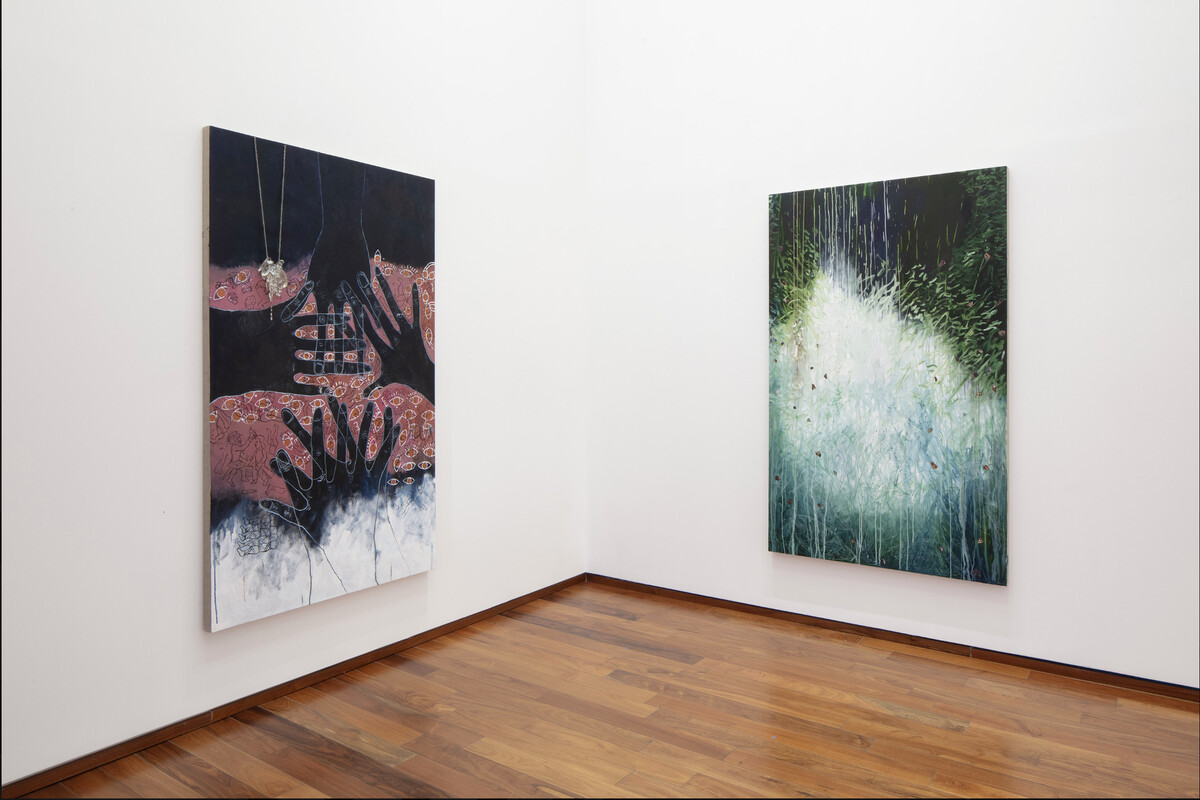
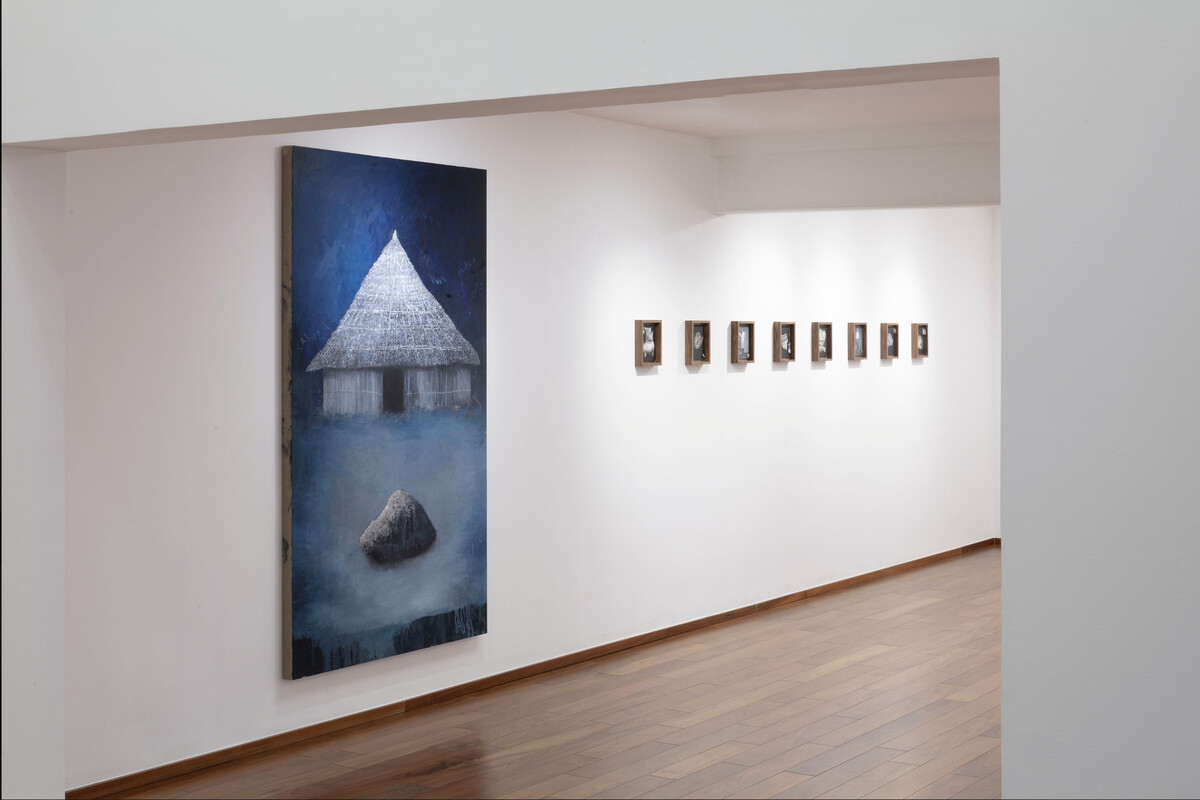
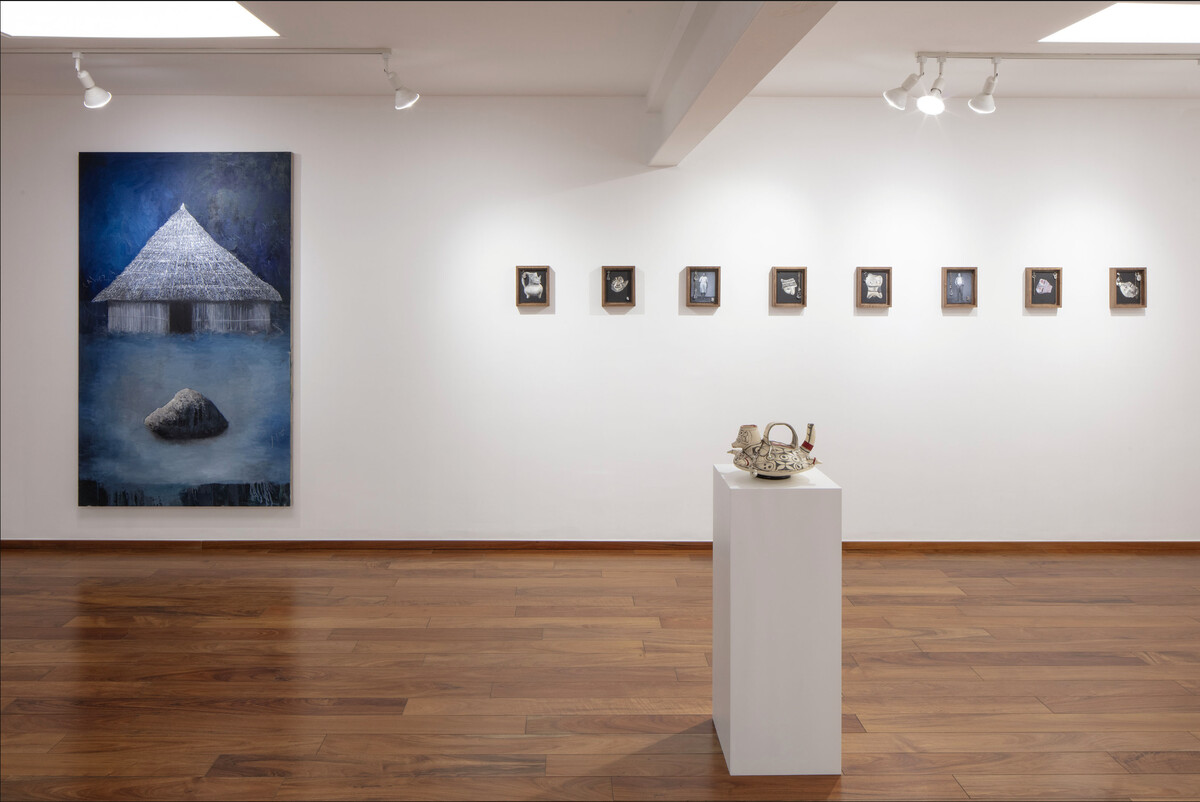
An Interview with Noé Martínez
Ilaria Conti: The series of small portraits on copper depicts faces adorned with tattoos derived from the archaeology of the Huastec region, combining personal and historical narratives. Could you share specific examples of details in these portraits—a gaze, a feature, or a tattoo—that exemplify your methodology of filling in archival gaps with embodied knowledge? How did you decide to work in such a small, intimate format in your practice, and what role does this format play in promoting a direct, meditative encounter between you and your ancestors?
Noé Martínez: The format is something I need to converse with my ancestors. I regard the small-format images as the result of engaging in dialogue with a presence. I say “presence” because it’s something or someone that doesn’t go away. For me, the border between death and the living universe is very porous. I have a way of thinking about my life and my cyclical, non-linear art such that life and death are part of the same thing, as are memory and the present. They aren’t split apart, just as space and time aren’t, either. So thinking about creating a small image is an intimate contact, but one that contains a collective history. The history of a culture, of the personal and the collective, are also part of the same thing.
The small paintings are, for me, a conduit between the living and the dead, a conduit between dreaming and waking. It’s a sort of meditation on the pictorial surface. They have a ritual poetics because they seek to make concrete, in a physical image, a process of introspection that has to be shown to the collective. It’s a ritual that revives a memory, or at least extends the life of memories.
I’m also thinking about a format of “survival:” a small piece of metal that you could carry around, like a notebook in a backpack; a small image you can take with you on the run, and that you can hide if need be. It’s a human scale, a migrant’s format, for someone who has to go on foot.
IC: In the large-format works, you blend elements from dreams with historical and cosmological elements, creating a stratified, almost surrealist narrative. Could you elaborate on the interaction between your visions and historical facts in these larger pieces? How do you blend these two sources of knowledge—dreams and archival research—in specific works, and how does this convergence shape the dream-like but profoundly political tone of your art?
NM: The political dimension of these images has two layers: one of denunciation, of making present something that has been erased in official history, but that is borne in the bodies of a group of people who were enslaved, and another dimension that appeals to images that have healed or fixed that wound until art has found the way of saying it.
From my political training, influenced by Zapatista thought and the recent autonomies of indigenous peoples in Mexico, I understand that recent struggles involve coalitions. This means that different ways of thinking, humanistic disciplines, and personal origins and histories converge when a substantial change crystallizes. The same thing is happening in my personal universe: my indigenous perspective and my western perspective are latent. Both forms of thought are something like an assembly in my head, in my ideas, and very often my task as an artist is to balance those two ways of thinking and get them to look at the same place as the animals that inhabit my body; in this case, getting archives and dreams to turn in the same direction, and that balance is a way of cutting two heads off of the same capitalist hydra, as the Zapatista women call it.
I believe that art becomes meaningful when the corners of the world are found, two poles that converge. Sometimes it’s almost bizarre, but art makes it into a reality. With images or words, it’s the power of a narrative. This narrative is a space of exhibition; it’s the most important thing for me. What history is being told? Narrative is the reconciliation of opposed or complementary worlds. It’s the union of memory and oblivion, of body and word.
IC: Your practice is situated at the intersection of personal memory, historical reconstruction, and decolonial critique. Do you see your work as creating a “third space” where colonial epistemologies are destabilized? If so, how does this space function relative to those who view it? How do you want your audiences to interact with and inhabit this liminal, transformative space?
NM: For me, it’s a space of revelation and encounter. What does the history of this exhibition reveal? For me, it presents a reality that has consequences for our relationships: the fact that we are part of an ecosystem. To swap ego for eco; meaning, the back story for this project is a history of rhizomes, of roots, something very much like the world of fungi, not like a pyramid of stratified beings. In this ecosystem there are no boxes that classify reality; so, lighting one spore on fire will have incalculable effects, and one drop of dew caught by a leaf will bring life back.
Art is the grand narrative of relationships with ritual, with language, with emotions, and with material culture, which is intertwined with relationships among people. The viewers’ relationship is that of an ecosystem, a collaboration so that a history gets told, created, and transmitted.
